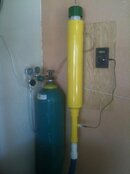How much is too much resistance on air draw into the compressor? I built a nitrox stick 2x 24 basically the Oxyhackers design (great book). I know there is going to be some resistance, but while breathing through it I can really feel the difference when I unplug the ½ part on the tee where the sensor screws in. I know there has been hundreds of these built with probably little to no compressor problems. I have a Coltri MCH16 Compact and running a 1 ¼ corrugated hose to the stick. Just curious.
Thanks
Damon
Thanks
Damon





